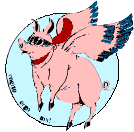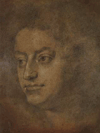Something I might call home-town nausea. I can get it in a
lunch room like this, or at the bend of a road, any country road,
where a telephone pole tips out of a clutter of dust-heavy weeds.
Or a track crossing, where you lean out to peer into nowhere, in
both directions, the rails a long blur with the hot air, like smoke,
flowing up. At such times it’s hard to tell where the nostalgia stops,
the nausea begins.
--Wright Morris, The World in the Attic
![]()
CHILDREN ARE ESSENTIALLY ALIEN versions of humanity. And I’m not really sure ontogeny recapitulates phylogeny, come to think of it.
As a child I was strange, in an unselfconscious, introverted and naïve way. Whatever I did or thought seemed right—else why would I think or do it? Life was amazingly self-evident. So whenever called to account by adults—“Why are you holding that Tinkertoy in your mouth?”—I felt betrayed, guilty, foolish and disoriented. I knew Kafka was merely describing “normal” childhood when I first read him.
In childhood no good ideas answered such interrogation—“Because I want to” or “Because it pleases me” or “It seemed like a good idea at the time” are inadequate, shaming rationales in the adult universe. So I practiced what the British military call “dumb insolence”—standing mute and being impudent by omission, a concept that eluded me. How could “no comment” be uppity? Yet in my heart I knew it was, for I despised the inquisition.
However, one action was an inadvertent, successful rebellion against rational conformity: I walked around town by way of alleys rather than by streets and corollary sidewalks. Given my druthers, I walked from A to B through interconnected alleys. I walked to and from grade school through a zigzag network of alleys, with short connecting streets at the beginning and end.
I could not have explained why I preferred alleys and walked them. They made me feel better—they were private, my own secret variation on the theme of journeying. They gave me mystery and the thrill of discovery. They also gave me a novel and uncensored view of ordinary neighborhoods.
I saw garages, chicken coops, sagging back porches, long abandoned jakes, oil drum trash containers, cinderblock refuse pits. And the unsorted addenda of life—rowboats peeling on sawhorses, heaps of ejecta impedimenta: Mason jars, car batteries with green beards of corrosion, bits of bicycles, scrap lumber, heaps of shingles or bricks or iron pipe.
Life from the alleyways was a dun-colored cubist collage, not the airbrushed art deco tidiness of front yards—front porches, rose bushes, trimmed barberry hedges. Litter and chaos, chief forces in a child’s life, ruled the alleys. Surprise dominated order. You might find a dead cat, a discarded bird cage, a perambulator intact but for one wheel, a brass picture frame holding a faded sepia photo of an extraordinarily old, ugly woman wearing a bonnet like a burst carbuncle.
Alleys were untended, unclaimed—potholed, paved with cinders, puddled, choked with random trash, excrescences of weeds, ripe bad smells, secret corruption. They might be dangerous—home of mad dogs, cats with crazed eyes, shabby older boys in dirty clothes who smirked cigarettes and sneered to fight you. Broken glass and sharp volcanic cinders crunched underfoot. Rusty nails lurked, tipped with lockjaw venom waiting to wound you mortally.
People worked and played and carried on secret lives in alleys. Garages were open, showing vignettes defined by chiaroscuro—a burly man half-swallowed by his shark-like yellow Pontiac Chieftain, a small bald fellow filing the blades on an old lawnmower, or a hearty sportsman with a fly-bedizened hat whipping a Shakespeare rod in figure eights to practice casting.
One man ran a refrigerator-repair shop in his garage. Another small auto body shop revealed Haephestus haloed by showers of daylight-bright sparks from a welding torch. A bottled-water business exhibited racks of blue-glass amphorae, jereboam-sized and iridescent.
The destitute and homeless moved through the alleys—to avoid the jeering world of success and for privacy and solitude, for opportunities to steal unconsidered trifles, like Autolycus filching shirts from hedges. I watched them shambling in autistic fogs, muttering, glancing fever-eyed across back yards. No cartoon pies cooling on windowsills, no bulldogs with rubber teeth, one million miles’ trudge from the Big Rock Candy Mountain. No easy marks to tap for spondulacks. Yard dogs moved them along with insistent yaps and snarls before they could commit an outrage.
One old woman I thought of as a “tramp” walked through the alleys pushing a broken baby stroller clanking with jars and bottles. She was swaddled, year round, in layers of shirts, sweaters and jackets, thick, blanket-like skirts, a babushka, draggy socks and men’s clodhopper work boots. She was, like a chameleon, a uniform background color—a purple-grey the tone of alley clinkers. She chewed snuff, her face screwed into a snarl. One morning I saw her shuffle over to a closed garage, ponderously hike up one leg and prop her boot on the wooden door. Standing thus spraddled, she urinated in a single copious rush, like a flung bucketful, one vast woosh! of expulsion. She shuddered all over and painfully lowered her foot, tottering. She straightened up, took her stroller and jangled down the alley.
Occasionally I passed sports or games—basketball backboards with desperate pickup games, a quartet of men like one of those comic dog paintings drinking beer and playing pinochle in an open garage, a croquet match on a green baize lawn, a young woman in her back yard practicing archery, riddling a straw-filled butt with gaily fletched arrows. It looked as pastoral as a Robin Hood play, but she worked at it like a chore or a penance.
Looking into back yards over fences or hedges was a guilty pleasure—a salacious act of minor-league voyeurism. Men wore undershirts, women sported head rags, teenagers sunbathed by portable radios. Inexplicable pantomimes unfolded—an old man peering into a bottle with desperate uncertainty, a woman weeping, shaking her head and waving a scrap of paper, two young girls in a violent, soundless scuffle that carried them all over the yard.
Enigmas of behavior and appearance presented themselves like pages in an emblem book to be studied—ogled—more closely than front-street superficialities. You could not loiter in front of a house, puzzling, without raising a response. But in alleys I was in a time tunnel, an observation post from the future, observing an aspic-preserved amulet from the ancient past, an action caught in amber. I could stop, hang over a fence and tease a tethered spitz dog or count old gold fish in a pond or contemplate wavy glass windows in a turreted Victorian manse. I could kibitz on a badminton match between two hefty teenage girls or watch a Dalmatian dog stalk a gibbering squirrel.
Walking the alleys was journeying on the bias—by indirections to find directions out, viewing the backside of life. Sometimes they intersected other alleys or curved or forked. They sheltered secrets—vacant lots, a rill teeming with micro-life, a chicken coop and run with gaudy Polish show birds twitching their topknots, uttering Chopinesque trills. Or a backyard aviary flickering with exotic finches and pastel budgies, animated aerial tapestry.
I passed a tiny job-printing shop, and the printer beckoned me to see how he cut, folded and bound a pamphlet just struck off. A sign painter meticulously lettered a logo on a delivery truck, using a long brush and a baton like a wizard’s wand. On the corner, a fruit and vegetable seller kept two old horses in a teeny stable, the air around rich with horseshit and moldering straw, the sweet hint of horse’s breath.
At another corner were an iron pump and an iron trough, revenants of the Horse Age. The pump, with vigorous priming, expelled a great cough of cold, clear water that tasted of rusty iron and made my fillings jingle like a crystal radio.
Near my grade school, at the end of my alley labyrinth, stood the motorcycle shop run by the father of my friend Wilbur Orville Wright. The little shed was flanked by big Indians and Harley Davidsons, by used police three-wheelers and delivery dogcarts, detached sidecars, cascades of chrome accessories, old tires, discarded saddles and teardrop tanks, headlights, tail lights. Mr. Wright rode a huge violently-yellow Indian to his day job as a junior-high janitor. At home, he waded around in motorcycle debris, assembling and disassembling machines.
His shop reeked of lacquer, gasoline, motor oil and leather softener—neatsfoot oil. Mr. Wright was a cheerful giant from deep in
Alleys led me to and from home. Our own alley was on my itinerary. At the top of our block was a church and churchyard maintained by mild Midwestern Quakers. At the bottom stood a small mansion which had lost a once-substantial carriage house and stables to fire. We played in the weedy foundations, which we called “The Old Barn” and which was to me as ancient a ruin as the walls of
Up the alley, a sporty character parked his new Chrysler Town & Country convertible, which I admired, touching the polished strips of wood reverently. Further up I teased the obnoxious pug dog who came to snuffle and yap through the fence. At the end of the block, I swerved across the alley to avoid lunatic lunges by two big, loud, anthropophagic collies precariously imprisoned behind a chain link fence.
The alley system was endless. I tried to explore newer, remote alleys. When I rode in the family car, I eyed alleys for their distinctive appeals. I saw that the new parts of town—postwar suburbs, G.I. tracts, National Home clusters, on-spec flotillas of prefabs—were alley-less. They featured sinuous streets (no predictable grid pattern) and spic-and-span new homes built back-to-back. Garages faced front brazenly. My back world of alleys was legislated away.
Henceforward, we lived one-dimensional lives, eyes front, no secrets, no hidden crannies, no occluded trash pickups and back-door deliveries, no private vistas and hedged bowers. By then I was outgrowing alleys, anyhow. No more shiftless mooning in my inexplicable dream world, adrift in reverie. I was a responsible teenager, hands out of pockets, no skulking, no aberrant behavior.
I walked home from junior high via ordinary streets. At home I switched on our new television set and watched the Army v. McCarthy hearings. With no political training, I still understood it. The jowly thug with the five o’clock shadow (no, not Nixon, the thug before him!) wanted me kept in my place—out of alleys, out of conspiracies, out of the CPUSA, out of subversive thought, deed or feeling. The old lawyer with the soft voice wanted him to leave me the hell alone.
Watching, I thought I would be good henceforth and walk on the sunny side of the street. This rover crossed over. . . ###
![]()
| jptArchive Issue 5 |
![]()
| Copyright 2008- WJ Schafer & WC Smith - All Rights Reserved |
| The Journal of Provincial Thought |


ALLEYS